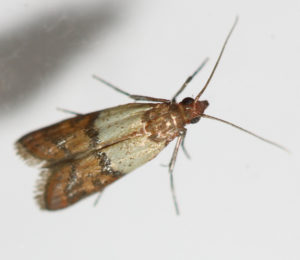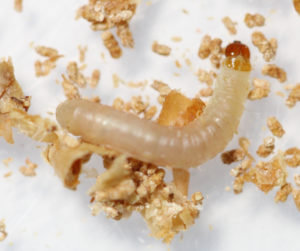
Indian meal moths are the most common pantry pest. The larval stage is the one that causes all of the damage. They will spin silken threads that web food particles together as they feed and crawl. Products that they infest include, but not limited to:
- Dried Fruits
- Powdered milk
- Cornmeal
- Flour
- Raisins
- Prunes
- Nuts
- Health food
- Seeds
- Bird seed
- Dog and cat food
- Fish food
Adults
Adults are:
- 3/8-inch long when at rest
- Have a wing span between 1/2 to 3/4 inch
- The outer 2/3 of the wing appears reddish-brown or bronze colored
- The inner 2/3 of the wing is light gray to ochre-yellow
- Head and thorax are reddish-brown
- Hind legs are gray
Larvae
The larvae or “caterpillars,” are about 2/3 inch when mature. They have a brown colored head with dirty white body. Their bodies can sometimes be tinted pink or green. The larvae are quite active and will molt four to seven times before pupating. The pupae are reddish-brown and about 3/8-inch long. The eggs are grayish to dirty white and can be anywhere from 0.3 to 0.5mm long.

Indian meal moth larva
Biology
Since adult moths live five to seven days, their main function is reproduction. Female Indian meal moths will lay between 60 to 300 eggs on or near the food material. These eggs will hatch in 2 to 14 days. The larval stage is where these insects do their damage and can last up to 41 weeks, depending on the conditions. The larvae will spin a silken cocoon when they are ready to pupate. The whole life cycle can be completed in as short as four weeks and as long as 300 days.